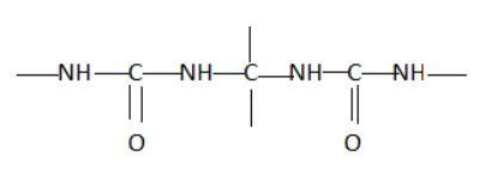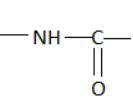
Which of the following represents a peptide chain?
A.

B.

C.

D.

Answer
143.7k+ views
Hint: A peptide chain is formed by combination of amino acids. An amino acid contains carbonyl and amine functional groups with a side chain specific to each amino group. We can detect a peptide link by looking for  group in the chain.
group in the chain.
Two amino acids combine to form a dipeptide which further goes on linking to form a peptide chain.
Complete step by step answer:
1: Threshold Energy is the minimum Kinetic Energy the molecules must have to bring about effective collisions between two reactant molecules which are considered as spheres, thus resulting in a chemical reaction between the two reactants.
2: Thus, we can write:
Threshold Energy = Average of the initial Kinetic Energy of reactants + Activation Energy (${E_a}$)
3: In case the reactants at the initial state (start of the reaction) have sufficient energy for the collisions, then the threshold energy is equal to Activation Energy. (${E_a}$)
4: Molecules that have a Kinetic Energy equal to or higher than the Threshold Energy will react.
Note:
The cut-off number of amino acids for peptides is traditionally taken between 2 and 50 amino acids, while for proteins it is 50 or more.
Peptide bond is a type of covalent chemical bond linking two consecutive alpha-amino acids from C1 of one amino acid to N2 of the other. Peptide bond is one of the strongest and most durable covalent bond. It can be broken in the laboratory using heat and acid.
 group in the chain.
group in the chain.Two amino acids combine to form a dipeptide which further goes on linking to form a peptide chain.
Complete step by step answer:
1: Threshold Energy is the minimum Kinetic Energy the molecules must have to bring about effective collisions between two reactant molecules which are considered as spheres, thus resulting in a chemical reaction between the two reactants.
2: Thus, we can write:
Threshold Energy = Average of the initial Kinetic Energy of reactants + Activation Energy (${E_a}$)
3: In case the reactants at the initial state (start of the reaction) have sufficient energy for the collisions, then the threshold energy is equal to Activation Energy. (${E_a}$)
4: Molecules that have a Kinetic Energy equal to or higher than the Threshold Energy will react.
Note:
The cut-off number of amino acids for peptides is traditionally taken between 2 and 50 amino acids, while for proteins it is 50 or more.
Peptide bond is a type of covalent chemical bond linking two consecutive alpha-amino acids from C1 of one amino acid to N2 of the other. Peptide bond is one of the strongest and most durable covalent bond. It can be broken in the laboratory using heat and acid.
Recently Updated Pages
How to find Oxidation Number - Important Concepts for JEE

How Electromagnetic Waves are Formed - Important Concepts for JEE

Electrical Resistance - Important Concepts and Tips for JEE

Average Atomic Mass - Important Concepts and Tips for JEE

Chemical Equation - Important Concepts and Tips for JEE

Concept of CP and CV of Gas - Important Concepts and Tips for JEE

Trending doubts
JEE Main 2025 Session 2: Application Form (Out), Exam Dates (Released), Eligibility, & More

JEE Main Exam Marking Scheme: Detailed Breakdown of Marks and Negative Marking

JEE Main 2025: Derivation of Equation of Trajectory in Physics

Electric Field Due to Uniformly Charged Ring for JEE Main 2025 - Formula and Derivation

Types of Solutions

Degree of Dissociation and Its Formula With Solved Example for JEE

Other Pages
NCERT Solutions for Class 12 Chemistry Chapter 6 Haloalkanes and Haloarenes

NCERT Solutions for Class 12 Chemistry Chapter 2 Electrochemistry

NCERT Solutions for Class 12 Chemistry Chapter 7 Alcohol Phenol and Ether

NCERT Solutions for Class 12 Chemistry Chapter 1 Solutions

Solutions Class 12 Notes: CBSE Chemistry Chapter 1

JEE Advanced Marks vs Ranks 2025: Understanding Category-wise Qualifying Marks and Previous Year Cut-offs




